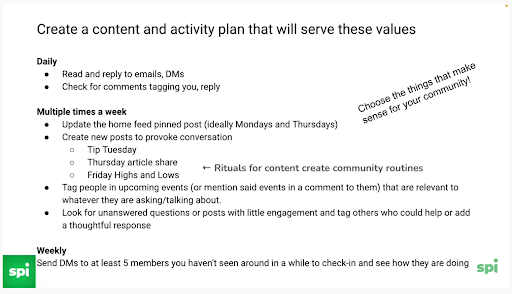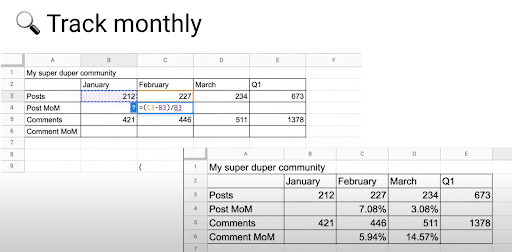Your community is like a garden; it needs to be tended—and you might even be surprised what grows in it!
But before you start planting, you need to have a strategy—and that’s what SPI’s CX Director Jillian Benbow covered in the third and final session of our March 23 CX Day event.
She outlined the five steps to creating and executing a strategy that will help your community succeed in the first 30 days and the long run:
We’ll run through them today—but if you really want to dig in (get it, gardening?), then catch the replay of Jillian’s session over on our YouTube channel.
This is the third in our three-part series recapping the sessions at our March 23 CX Day event. Read part 1 (“Audience Building vs. Community Building” with Pat Flynn and Matt Gartland) and part 2 (“How to Make Your Community More Valuable” with Andy Guttormsen and Alexis Teichmiller of Circle).
Step 1: Start with Your Purpose
Your purpose is what makes your community worth belonging to. If you don’t define your community’s purpose, then you don’t really have a community.
There are three questions you need to answer:
- What purpose does your community serve?
- What value does your community offer?
- Who would benefit from participating in your community?
Let’s take a stab at answering these three questions using simple statements that will guide the direction of your community.
It may feel daunting to come up with the perfect statements—but don’t fret about that right now. Your community’s purpose will likely evolve anyway! (Community moves fast.)
Your Community’s Purpose Statement
First, come up with a purpose statement that defines the aim of the community:
The purpose of my community is _________.
Here are a few examples of how to fill that in:
- … to help bloggers build their photography skills.
- … for local parents to support each other.
- … to allow calico cat lovers to share pictures of their pets.
Now let’s build on the purpose statement with…
Your Community’s Value Statement
Your value statement that gets a little more specific and explains what someone will gain by joining:
The value my community offers is ______________.
Here’s our value statement for SPI Pro:
The value my community offers is networking and relationship-building opportunities with like-minded entrepreneurs in similar stages of business.
Your Community’s Benefit Statement
For the third statement—who will benefit—you can reference your purpose and value statements. But get specific!
In the case of SPI Pro, our target audience isn’t “entrepreneurs” broadly, but those with intermediate or advanced businesses—so, not beginners.
So our statement might look something like:
The people who will benefit from our community are entrepreneurs with established businesses who need support to help them get to the next level.
Once you’ve defined your benefit statement, you can think about the specific needs and interests of your target audience and how you could serve those needs in your community.
Which brings us to…
Step 2: Design Your CX Strategy
Now you need to design a community strategy that will help your community deliver on its purpose! This is where the rubber meets the road.
And when it comes to community, you want to be thinking about designing for engagement—getting people to post more often, attending events, that sort of thing.
It’s all about participation. And driving participation means having great programming.
How do you figure out what kind of programming will provide the value your members seek and get them to engage?
Start by thinking of three benefits your ideal member would value the most. When we did this exercise for SPI Pro, we landed on networking, relationship building, and business growth.
Then think about how you can provide your members with those benefits. These are the offerings we came up with to support our three benefits:
- Networking: host networking events
- Relationship building: offer masterminds or focus groups
- Business growth: provide spaces dedicated to business growth topics
Next, create a content and activity plan that will support your strategy and drive participation. Here’s what that might look like:

All this stuff—the strategy design—is the meaty middle of things when it comes to building a community, and it may sound like a lot!
The key is to not bite off more than you can chew, especially in your first 30 days.
Do a few things really well, and when you’re ready you can ask your members what else they’d like to see.
Step 3: Onboard with Care
Whether you’re just launching a community, or trying to grow one, you want to get your new members to log in, participate, and return.
This means having a solid plan for how you’ll onboard new members so they feel welcomed and comfortable as soon as they join.
To get them to log in, create an email onboarding sequence highlighting the best parts of your community, with clear CTAs. This will build excitement and a sense of possibility.
To spark participation, offer programming specifically for new members to introduce and acclimate them to the community. Hold their hands and anticipate their questions so they know they’re in the right place off the bat.
And the key to inspiring people to return is to help them build relationships, so provide early opportunities to connect your members with each other.
Step 4: Measure Success
Why bother creating an engagement strategy if you don’t plan to monitor the results?
You’ll only know whether your community strategy is paying off if you track and measure the right metrics.
So… what should you track and measure?
For most communities, things like posts, comments, and active users (all on a monthly basis), as well as event RSVPs and attendance numbers, are important to track.
How should you track these metrics? It’s simpler than you might think:
- Benchmark the metrics you want to track (e.g., for the first month).
- Track them monthly, and compare the changes.
Here’s what that could look like, in a simple spreadsheet:

Read more: The Most Important Metrics for Your Membership Community
Step 5: Fine-tune!
You’ve defined your community’s purpose and value, created a strategy, defined your programming, set up your onboarding, and even started tracking the important metrics.
And now you are done keep moving forward!
Community building is constant, so just keep swimming.

Edit and adjust as you grow, and work with your members to launch new programming as it makes sense.
And above all, enjoy it, because community should be fun!

 Ray Sylvester
Ray Sylvester


